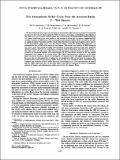| dc.contributor.author | Andreae, M. O. | |
| dc.contributor.author | Berresheim, H. | |
| dc.contributor.author | Bingemer, H. | |
| dc.contributor.author | Jacob, Daniel James | |
| dc.contributor.author | Lewis, B. L. | |
| dc.contributor.author | Li, S.-M. | |
| dc.contributor.author | Talbot, R. W. | |
| dc.date.accessioned | 2015-03-12T14:46:20Z | |
| dc.date.issued | 1990 | |
| dc.identifier.citation | Andreae, M. O., H. Berresheim, H. Bingemer, D. J. Jacob, B. L. Lewis, S.-M. Li, and R. W. Talbot. 1990. “The Atmospheric Sulfur Cycle over the Amazon Basin: 2. Wet Season.” Journal of Geophysical Research 95 (D10): 16813. doi:10.1029/jd095id10p16813. | en_US |
| dc.identifier.issn | 0148-0227 | en_US |
| dc.identifier.uri | http://nrs.harvard.edu/urn-3:HUL.InstRepos:14121772 | |
| dc.description.abstract | We determined the fluxes and concentrations of atmospheric sulfur species at ground level and from aircraft over the Amazon Basin during the 1987 wet season, providing a comprehensive description of the sulfur cycle over a remote tropical region. The vertical profile of dimethylsulfide (DMS) during the wet season was found to be very similar to that measured during the dry season, suggesting little seasonal variation in DMS fluxes. The concentrations of hydrogen sulfide (H2S) were almost an order of magnitude higher than those of DMS, which makes H2S the most important biogenic source species in the atmospheric sulfur cycle over the Amazon Basin. Using the gradient-flux approach, we estimated the flux of DMS at the top of the tree canopy. The canopy was a source of DMS during the day, and a weak sink during the night. Measurements of sulfur gas emissions from soils, using the chamber method, showed very small fluxes, consistent with the hypothesis that the forest canopy is the major source of sulfur gases. The observed soil and canopy emission fluxes are similar to those measured in temperate regions. The concentrations of SO2 and sulfate aerosol in the wet season atmosphere were similar to dry season values. The sulfate concentration in rainwater, on the other hand, was lower by about a factor of 5 during the wet season. Due to the higher precipitation rate, however, the wet deposition flux of sulfate was not significantly different between the seasons. The measured fluxes and concentrations of DMS, H2S, and SO2 were consistent with a model describing transport and chemistry of these sulfur species in the boundary layer. The concentrations of aerosol and the sulfate deposition rate, on the other hand, could only be explained by import of significant amounts of marine and anthropogenic sulfate aerosol into the Amazon Basin. | en_US |
| dc.description.sponsorship | Engineering and Applied Sciences | en_US |
| dc.language.iso | en_US | en_US |
| dc.publisher | Wiley-Blackwell | en_US |
| dc.relation.isversionof | doi:10.1029/JD095iD10p16813 | en_US |
| dash.license | LAA | |
| dc.title | The atmospheric sulfur cycle over the Amazon Basin: 2. Wet season | en_US |
| dc.type | Journal Article | en_US |
| dc.description.version | Version of Record | en_US |
| dc.relation.journal | J. Geophys. Res. | en_US |
| dash.depositing.author | Jacob, Daniel James | |
| dc.date.available | 2015-03-12T14:46:20Z | |
| dc.identifier.doi | 10.1029/JD095iD10p16813 | * |
| dash.contributor.affiliated | Jacob, Daniel | |


